Ford covers the long and short of SUV field
Filed under: Weekly test drives, Autos
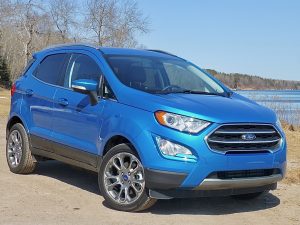
At the most-compact end of the spectrum is Ford’s new EcoSport, with a 1.0-liter turbocharged 3-cylinder engine.
Here is an interesting irony I’ve stumbled across — or maybe run over — while alternately complaining and evaluating the runaway passion U.S. consumers have for SUVs: In the ongoing race to fit an SUV into every available niche in the marketplace, we haves reached the point where all of them have positive reasons for their existence.
Consider Ford. While reaching out all over the world, Ford has a pretty impressive stable of SUVs, starting with the compact Escape, then moving up to the Edge, then the Explorer, and finally the Expedition. Nice group, there. But wait, we have to plug in the Flex, which is that boxy but eminently useful midsize wagon/SUV compromise. And for 2018, there is a new player at the short end of the roster.
The surprising and often-overlooked new entry in the Ford array is the EcoSport, a stubby little vehicle I drove briefly and saw at the Detroit and Chicago Auto Shows. Because I am most attracted to reduced-size vehicles that do the work of their larger brethren, I was happy to get an EcoSport for a week’s analysis, right after I had driven an Expedition for a week. With late-spring winter storms coming and going, it gave me an interesting perspective on how both might handle nasty weather, too. The EcoSport might be the biggest surprise of the whole batch, but hitting the high spot and the low spot of them all is required.
If you tow an RV trailer or horse trailer, or have otherwise realistic needs to tow large objects, and you can afford to buy and drive a large SUV, the crop now on the marketplace makes an impressive group. If you prefer a card, you’d better hurry. Ford announced the last week of April, 2018, that it intends to phase out its North American sales of all cars except the Mustang and Focus over the next few year because of the greater popularity of trucks and SUVs.
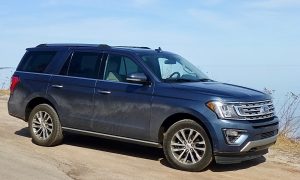
Need a large SUV for hauling and towing? Redone Expedition has aluminuim body, 3.5-liter EcoBoost power, and impressive features..
The Expedition got Ford’s major makeover for 2018, switching to add power and lose weight at the same time. Going to a lot of aluminum in the body, similar to the latest F-150 pickup, relieved a lot of weight without compromising the solild structure over the steel frame.
For power, the Expedition offers only one engine, the 3.5-liter EcoBoost V6, which comes with 375-400 horsepower and 470-480 foot-pounds of torque, blown through twin-turbochargers. With a 10-speed automatic, that powertrain sends the Expedition sailing off in a quick and sprightly manner, and it handles well in curves and corners, while riding smoothly in all circumstances. It may also leave you with barely 20-mpg or maybe just under 20, which is OK with all that available power, but could be a shortcoming against some competitors.
You can get an off-road package on top of that, although it’s hard to visualize many cognizant folks taking such a large land-yacht off-road. Of more use is the towing capacity, which registers 9,300 pounds. Read more
New Buick Regal, Avenir stretch expectations
Filed under: Weekly test drives, Autos
Buick has led a charmed life through the pitfalls of General Motors cutbacks and a highly competitive global auto industry. Some are puzzled by Buick’s continued success, or even existence. But it all makes sense, even if some of its newest vehicles are both surprising and intriguing.
The biggest surprise is the Regal TourX, a curiously sized and shaped station wagon that seems surprisingly low and amazingly long.
More subtle, perhaps, is the curiously named high-end version of the very successful Buick Enclave SUV, named the Avenir. It conjures up the idea that somebody, perhaps with a New Jersey accent, might have meant to name it “Avenue,” but missed, just a bit.
By chance, I got the opportunity to spend a week test-driving both vehicles, which was a coincidence on its own. I got the two Buicks together, during one of those rare spells of Upper Midwest springtime — a rare couple of days of 50 degrees and sunshine on the North Shore of Lake Superior. As if to make sure I got valid tests of both vehicles, Mother Nature kicked in one of those 2018-special weeks, blasting Duluth with an 8-inch blizzard and accompanying it with some harsh winds off the big lake.
No worries, because both vehicles have all-wheel drive, and are either “soft” SUVs or can impersonate them.
I don’t mean soft in the weak sense, but more in the less-than-harsh suspension area, where both handle well enough but don’t conjure up the idea that you probably should go barreling through the woods on off-road adventures.
The Enclave has been a favorite of mine since it was introduced, because it came out about the time that the huge General Motors group of SUVs — the Suburban, Tahoe, Escalade, and GMC Yukon and Ford Expedition and Navigator — had all seemed to be headed for extinction, and the Enclave seemed perfectly sized to step in as a three-row people hauler. The Enclave even sprung a smaller sibling, the Encore, as in what can you do for an Encore? Then came the Envision, as in, can you envision enough room in the marketplace to fit another SUV in between the Enclave and Encore? Read more
Mazda6 bridges model gap with 2017.5
Filed under: Weekly test drives, Autos

The Mazda6 always has had sporty lines, and the 2017.5 upgrade adds interior features and such functions as G-Vectoring.
If you had never seen the most recent version of the Mazda6 sedan, and got a chance to spend some time with a 2017 model, chances are you would be impressed at how such an impressive, state of the art sedan could have eluded your notice.
The Mazda6 is the small Japanese company’s flagship sedan, officially midsize in the same way that the Honda Accord, Toyota Camry, Nissan Altima, Volkswagen Passat, Ford Fusion and Chevrolet Malibu are midsizers.
I had not driven a 2017 Mazda6, although it always has been one of my favorite cars because of its tight handling, sporty performance and flashy appearance. Pretty hard to beat that trio of assets.
When I discussed some test drives upcoming, I asked if the distribution company happened to have any 2018 Mazda6es, and he said they hadn’t seen one, “but we have a 2017.5,” he said.
What I remember about the last Mazda6 I had driven, maybe a 2015 or 2016, was that the interior was basic and simple, which in contemporary vernacular means non-luxurious.
From an engineering standpoint, nobody matches Mazda’s dedication. Others are excellent, but in my opinion, Mazda is on top. The Skyactiv engine technology is just one of those features. A more recent one is the elaborate G-Vectoring technique to limit torque to the outside front wheel in tight cornering, virtually coaxing the driver to turn at the first moment he should.
The G-Vectoring was put in place on the CX-5 and the Mazda3 a year ago, but it missed this cycle of the Mazda6.
So what could knowing a new and improved Mazda6 is coming soon, to upgrade the present car — the 2017 model — to completely redo the interior, to slightly tweak the exterior, and to install the G-Vectoring to the Mazda6?
I had no idea what the 2017-and-a-half would look like, so I paid extra attention to it when it showed up from the Chicago press fleet. It was bright red, or, in Mazda terms, Soul Red Metallic. Mazda, it must be noted, has at least three different red colors for the exteriors of its cars and SUVs, with the newest one being exclusive to the CX-5 compact SUV. That is my favorite of the array of reds, but they all are attractive. The test car was the GT model, which means a few extra sporty touches. Read more
Q60 Coupe means alpha-numeric sports-luxury
Filed under: Weekly test drives, Autos
Spend a few days driving up and down the freeway in the Infiniti Q60 coupe and you will be impressed by the power and the handling and the comfort, and maybe most by the knowledge that you look so darn cool in that sleek sporty car.
After you’re fully acquainted with its driving and handling assets, one of the last items you might find is the little rocker switch on the console, just southwest of the shift lever. Look closely, and you realize it is a driving mode selector. Click it and a readout shows that you can select eco, normal, snow, or sport, or sport-plus.
With most of these devices, your car might already be firm enough, and making it firmer could become harsh. The Q60, however, is firm enough but never even hints at harsh, so switching it to Sport-plus turned it into a quite-different ride. Quicker steering, firmer cornering feel, and an engine that goes from swift to swifter, making you feel that you should use the steering wheel paddles to truly appreciate the sportiness yoiu’ve discovered.
The car in question is not just the Q60, but a beautiful rad metallic color that defines its full name — the 2018 Infiniti Q60 Red Sport 400 AWD. Flipping that switch, which goes back to a default “standard” setting when you start up again, transforms the vehicle from a beautiful boulevardiering sports coupe into something that feels like it might have been designed for the track but allowed out on the street.
You may be, as I am, forced to stop and think whenever Nissan-Infiniti hits you with a name that starts with Q, or QX where there used to be G and a number. But whatever the designation, the technology remains ever-improving.
If you aren’t currently impressed with what Nissan/Infiniti has been doing with engines in recent years, you haven’t been paying attention. It’s highest-tech 2.0-liter turbocharged 4 is amazing, and Mercedes uses it in its C-Class and smaller sportier SUVs. It is just bringing to market a new concept that involves variable compression, which alters the engines compression ratio and thus provides almost infinite valve-timing range. Read more
Lincoln Navigates back to top of luxury SUVs
Filed under: Weekly test drives, Autos
If you had a lot of what they call “disposable income” and you wanted to take the family on vacation, you might charter a plane. You would not pick something small, and instead might choose a gigantic 747.
No, wait a minute. They’ve discontinued the 747, so we can’t charter one.
But then again, the Lincoln Navigator seemed destined to become a historical footnote a few years ago, too, right along with the Chevrolet Suburban and Tahoe, Cadillac Escalade, Ford Excursion and all other manner of humongous SUVs, because of our quest for improved fuel efficiency and better emissions. And now we seem to have forgotten all of that, and luxury-vehicle seekers are lining up to drop six-figure checks on the biggest, baddest and most luxurious trucks and SUVs on the market.
With that, the 2018 Lincoln Navigator speeds onto the scene with power and all-wheel-drive grip, as if to declare itself biggest, baddest, etc. So maybe there’s hope for the 747, too.
The only problem is, it appears that even auto journalists can’t decide what’s a truck and what’s an SUV anymore. Years ago, preparing for the car of the year and truck of the year awards at the Detroit Auto Show, I voted to not expand to add utility of the year as a third category. Nobody cared. My concern was that with a huge crop of mid and compact SUVs hitting the market, there might be years when a legitimate truck wouldn’t be coming out new, and leaving trucks with SUVs would keep the integrity of our votes intact. The decision went the other way, and this year we see the result: There are no new trucks, so the committee decided to make the Chevrolet Colorado midsize pickup one of three finalists, even though it was just a cladded-up, off-road version of an existing truck. The other two finalists would be the Ford Expedition and Lincoln Navigator, both of which used to be large SUV by anyone’s measure. justification to evaluate them as trucks was they are body on frame.
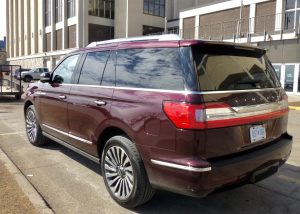
Wider, though a tad shorter than a Suburban, the Navigator is roomy throughout, including the third-row seat.
Whatever. Turns out, he Navigator won truck of the year. I remained a skeptic right up until a recent week when a new 2018 Navigator 4×4 Reserve was delivered for me to road test. It was shiny black, as anyone could tell from a glance out the window. Except it was not. Another illusion. When you got close, you could tell it was a subtle, not-quite-black, dark color, with some red to it.
Officially, it is listed as “Burgundy Velvet Tinted Clear Coat,” and it was stunning, making the bright chrome grille and stylish 22-inch alloy wheels jump out at you. Your first impression is that this is a bi-i-i-ig SUV. Gigantic. It is so big that when I later saw one from a distance, the view from the rear corner made me think I was looking at one of those new extra large Suburbans. THAT big.
Walk up and stand next to it and the Navigator will dwarf you. It is 76.1 inches tall, with a 221.9-inch length, 131.6-inch wheelbase, and a 79.9-inch width. At 6,330 pounds, the Navigator can tow 8,100 pounds of trailer.
Part of its illusion of size, which is no illusion but more fact, is the flashy wheels are 9.5-inches wide and 22 inches in circumference. Now, we aren’t going to estimate the price, but let’s assume buying replacement 22-inch tires will cost more than a reasonable consumer might be interested in paying.
However, I do have to restrain my usual sarcasm when dealing with trucks or SUVs I would normally accuse of being too big, because people are plunking down enormous quantities of money to buy these beasts. And the fellow in the White House is ordering his new EPA puppet to roll back former President Obama’s strict emission and fuel economy standards, to the applause of all the U.S. manufacturers who want nothing more than to unleash the largest of large trucks with the least economic of engines in a return to the 1970s, presumably.
Interesting, but one of the most impressive things about contemporary cars and trucks is that these companies continue to make higher and higher technology engines that produce more and more power yet still get more and more miles per gallon. Somehow, U.S. manufacturers would trade all that for cheaper-to-build, less-efficient engines that are more foul-running and will get worse fuel economy.
The test Navigator provided a sticker sheet that discreetly neglected to list a base or as-tested price. Checking a few car magazines, we can deduce that a Navigator will cost a base price of about $75,000 up to about $98,000, with gusts up to and over the magic $100,000 barricade.
Seems to me, prices like that could make foreign-make engines and the vehicles that come wrapped around them more popular, simply because intelligent people might prefer 30-plus miles per gallon to 15. I got a top of 19 mpg. But we can just wait to see if the U.S. manufacturers cut the sticker prices of these giant SUVs once the EPA says they can make less costly engines.
Ironically, companies like Ford have already made the plunge to high-tech, and they have done a good job, mostly. The Navigator, for example, comes with a 3.5-liter V6 EcoBoost engine, which means it is twin-turbocharged and can be tuned to turn out a lot of power. It is also used in the F-150 Raptor. The test vehicle shows 450 horsepower at 5,000 RPMs, and 510 foot-pounds of torque at 3,500 RPMs from its 3.5-liter V6. That is more horsepower than Cadillac can extract from the 6.2-liter V8 in its 6.2-liter V8.
Once you open the door on the Navigator, you realize how happy you are to spot the grip handles to let you pull yourself up and in. That’s before you spot the moving running board that is coming out to meet you. Handy.
The black leather front bucket seats are wide and comfortably supportive, and as you settle into it and start fiddling with the 30-way electric adjustments of your bucket, you are also taken by the overriding feeling of luxury, which is everywhere.
And then you push the button and start the Navigator, and all you need is someone to point to where the gearshift might be located. The 10-speed automatic with overdrive is shifted by a thin, horizontal row of push-buttons, located along the lower edge of the radio-navigation screen and above the lower dash-center stack-console area where you might expect to find a modern shifter.
Worked great, though, once you got used to it and it shifted readily with the paddle shifters on the steering wheel.
Driving the Navigator was easy. For such a big beast, it handled well and gave back only moderate sway, which you could eliminate by switching the mode switch from normal to “excite,” which tightens the steering, stiffens the suspension and holds shift points longer.
A panoramic sunroof adds to the luxurious feel, but with all that room you also feel guilty if you have fewer than six occupants. Opening the rear door shows off a roomy second row area, with a fold-down center armrest to go from three seats to two and a console. One of the neat features is that when you want to put someone — and we’re talking children or adults — into the surprisingly roomy third-row seat, you fold the outer second-row seat forward and it slides what seems like a foot forward, which presents an easy-access opening to hop through and reach the far rear.
I had fun wrestling with the second-row seats, then I learned that there is a power switch that controls fold-tip-slide action. No wrestling is required.
Naturally, the Navigator has all the latest safety gadgets, for lane warning and control, surround view of any and all things approaching from any and all directions, blind-spot alert, a 20-speaker audio upgrade, and all the connectivity gizmos you might want, including some things you didn’t know you wanted, like a wireless charging pad.
What would you expect from the Navigator, which we can welcome as 2018 truck of the year in a year when big trucks are making a big — and we mean BIG — comeback.


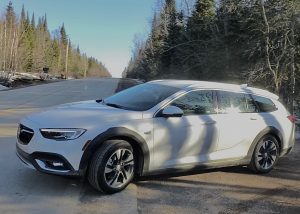

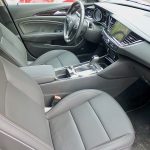
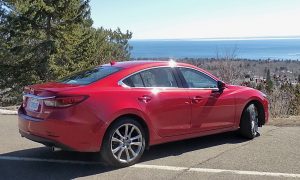
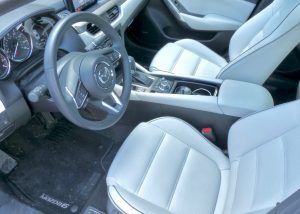
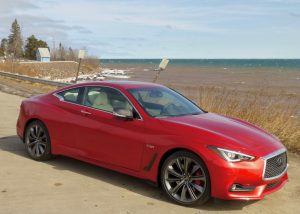
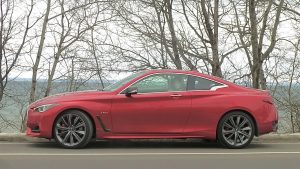
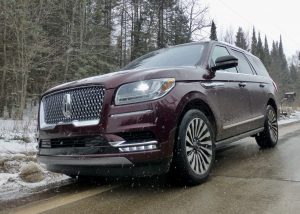
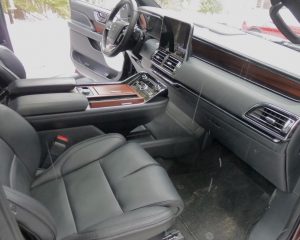
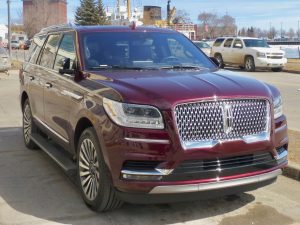

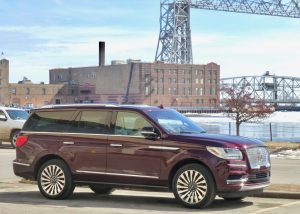
 John Gilbert is a lifetime Minnesotan and career journalist, specializing in cars and sports during and since spending 30 years at the Minneapolis Tribune, now the Star Tribune. More recently, he has continued translating the high-tech world of autos and sharing his passionate insights as a freelance writer/photographer/broadcaster. A member of the prestigious North American Car and Truck of the Year jury since 1993. John can be heard Monday-Friday from 9-11am on 610 KDAL(www.kdal610.com) on the "John Gilbert Show," and writes a column in the Duluth Reader.
John Gilbert is a lifetime Minnesotan and career journalist, specializing in cars and sports during and since spending 30 years at the Minneapolis Tribune, now the Star Tribune. More recently, he has continued translating the high-tech world of autos and sharing his passionate insights as a freelance writer/photographer/broadcaster. A member of the prestigious North American Car and Truck of the Year jury since 1993. John can be heard Monday-Friday from 9-11am on 610 KDAL(www.kdal610.com) on the "John Gilbert Show," and writes a column in the Duluth Reader.